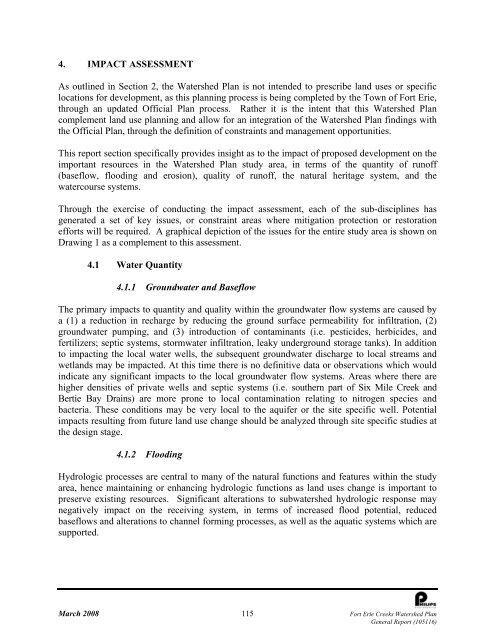Fort Erie Creeks Watershed Plan - Niagara Peninsula Conservation ...
Fort Erie Creeks Watershed Plan - Niagara Peninsula Conservation ...
Fort Erie Creeks Watershed Plan - Niagara Peninsula Conservation ...
Create successful ePaper yourself
Turn your PDF publications into a flip-book with our unique Google optimized e-Paper software.
4. IMPACT ASSESSMENT<br />
As outlined in Section 2, the <strong>Watershed</strong> <strong>Plan</strong> is not intended to prescribe land uses or specific<br />
locations for development, as this planning process is being completed by the Town of <strong>Fort</strong> <strong>Erie</strong>,<br />
through an updated Official <strong>Plan</strong> process. Rather it is the intent that this <strong>Watershed</strong> <strong>Plan</strong><br />
complement land use planning and allow for an integration of the <strong>Watershed</strong> <strong>Plan</strong> findings with<br />
the Official <strong>Plan</strong>, through the definition of constraints and management opportunities.<br />
This report section specifically provides insight as to the impact of proposed development on the<br />
important resources in the <strong>Watershed</strong> <strong>Plan</strong> study area, in terms of the quantity of runoff<br />
(baseflow, flooding and erosion), quality of runoff, the natural heritage system, and the<br />
watercourse systems.<br />
Through the exercise of conducting the impact assessment, each of the sub-disciplines has<br />
generated a set of key issues, or constraint areas where mitigation protection or restoration<br />
efforts will be required. A graphical depiction of the issues for the entire study area is shown on<br />
Drawing 1 as a complement to this assessment.<br />
4.1 Water Quantity<br />
4.1.1 Groundwater and Baseflow<br />
The primary impacts to quantity and quality within the groundwater flow systems are caused by<br />
a (1) a reduction in recharge by reducing the ground surface permeability for infiltration, (2)<br />
groundwater pumping, and (3) introduction of contaminants (i.e. pesticides, herbicides, and<br />
fertilizers; septic systems, stormwater infiltration, leaky underground storage tanks). In addition<br />
to impacting the local water wells, the subsequent groundwater discharge to local streams and<br />
wetlands may be impacted. At this time there is no definitive data or observations which would<br />
indicate any significant impacts to the local groundwater flow systems. Areas where there are<br />
higher densities of private wells and septic systems (i.e. southern part of Six Mile Creek and<br />
Bertie Bay Drains) are more prone to local contamination relating to nitrogen species and<br />
bacteria. These conditions may be very local to the aquifer or the site specific well. Potential<br />
impacts resulting from future land use change should be analyzed through site specific studies at<br />
the design stage.<br />
4.1.2 Flooding<br />
Hydrologic processes are central to many of the natural functions and features within the study<br />
area, hence maintaining or enhancing hydrologic functions as land uses change is important to<br />
preserve existing resources. Significant alterations to subwatershed hydrologic response may<br />
negatively impact on the receiving system, in terms of increased flood potential, reduced<br />
baseflows and alterations to channel forming processes, as well as the aquatic systems which are<br />
supported.<br />
March 2008 115 <strong>Fort</strong> <strong>Erie</strong> <strong>Creeks</strong> <strong>Watershed</strong> <strong>Plan</strong><br />
General Report (105116)
















